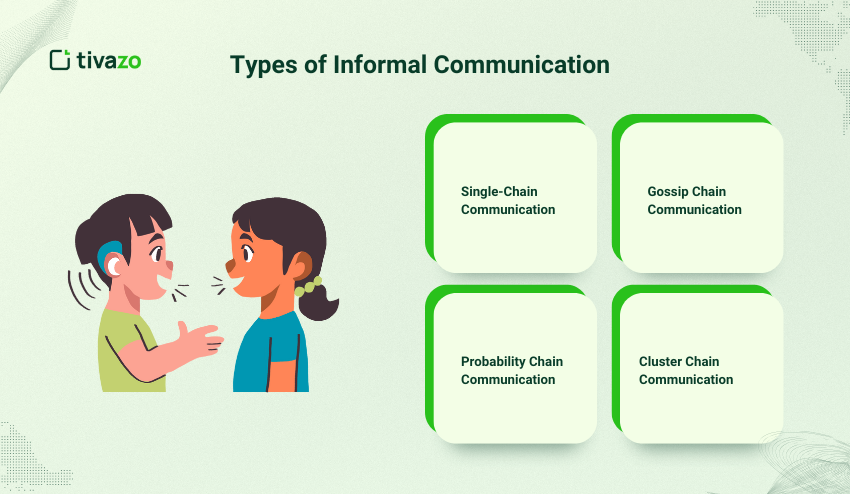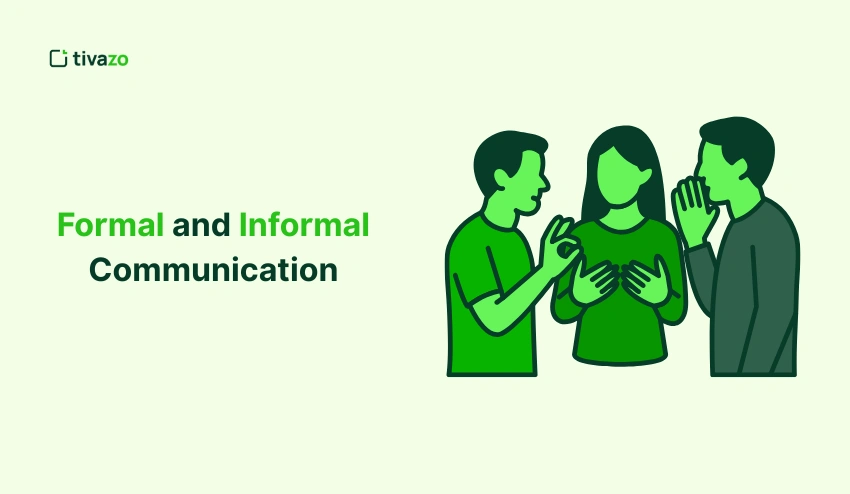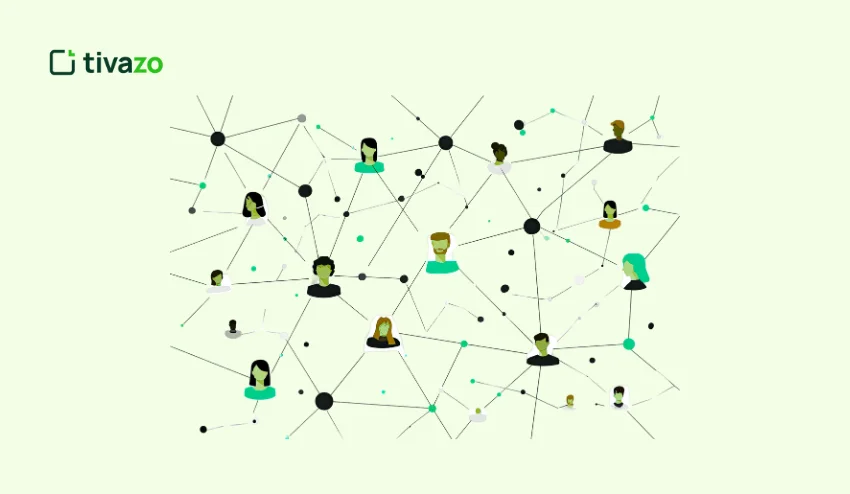Have you ever wondered why certain conversations run in a natural manner, whereas others are guided by a strict procedure? It may be a simple conversation with your workmate, or it may be a formal meeting with your supervisor; the manner in which we communicate influences relationships, choices, and career achievement at the workplace.
Communication within any organization or even social group occurs in two broad forms, which are formal and informal communication. It is important to understand the distinction between them in order to enhance cooperation, prevent misunderstanding, and create a positive communication culture.
Any interaction, either personal or professional, is based on communication. However, not everything is communicated in the same manner. There are those that are official, documented, and have laid down the lines of command, and there are those that are made during the coffee breaks or the quick talks.
In this blog, we’ll discuss what formal and informal communication are, the types of communication, the significance of communication, and the major differences between formal the two communication. You will also discover how formal and informal communication are critical in the workplace and business communication, as well as the real-life examples of these concepts in action.
👉You May Also Like: Group Communication: 7 Powerful Strategies
What is Formal Communication?
Formal communication refers to the official communication through an organization or institution that involves a structured channel of communication. It typically moves along the lines of hierarchy, such as managers to employees or between departments, and is recorded to keep track of it and hold them accountable.
When it comes to formal and informal communication, the formal one is usually regulated by the company policies, rules, and company structure. Examples of these would be business meetings, company memos, official emails, reports, and presentations. These make sure that messages are not ambiguous, they are professional, and they are delivered to the target audience via the right channel of command.
Types of Formal Communication
Formal communication is done in certain paths in an organization so that information is passed in a direct and effective manner. The knowledge of the various formal communication types will assist professionals in being very organized and avoiding miscommunication at the workplace. The formal form of communication in the broad context of formal and informal communication implies that all messages pass through the right channel to be accountable and understandable.

1. Downward Communication
The communication flows downwards, from the top level to the lower-level workers. It contains orders, guidelines, business policies, and official statements. This form of formal communication is used to make sure that goals and expectations are well communicated to all the people in the organization.
In formal and informal communication, downward communication is a way of ensuring discipline and order, hence enabling the employees to comprehend their roles and responsibilities, and also ensuring that they align with the overall organizational goals.
📖Read More: 5 Best Tips for Better Workplace Conversation Skills
2. Upward Communication
Upward communication goes downwards between the subordinates and the managers or the higher authorities. It might contain reports, feedback, performance reviews, or requests. This form of communication enables the employees to give their views, update on progress, or they can raise issues.
In the context of formal and informal communication, upward communication facilitates openness and trust, whereby the management at the ground level is assured of giving the right information to the management to make the right decisions.
3. Horizontal Communication
Horizontal communication (or lateral communication) occurs between employees or departments of the same hierarchy. It is frequently applied in coordination, teamwork, and problem-solving. As an example, a sales team that works with a marketing team on a campaign.
Horizontal communication is one of the different forms of formal and informal communication, which improves teamwork and efficiency by allowing peer-level communication using formalized channels such as official meetings or written communication.
4. Diagonal Communication
Diagonal communication is not only between departments but also within hierarchies, e.g., a project manager can communicate with a finance officer or HR specialist. Such formal communication assists in minimizing time wastage and enhancing departmental coordination.
Diagonal communication in the formal and informal communication context offers flexibility to the formal structures in a way that enhances quicker decision making, but at the same time, professionalism and documentation.
What is Informal Communication?
The unofficial, spontaneous, and natural way of exchanging information with others without adhering to a definite organizational format is known as informal communication. Informal communication occurs, whereas formal communication is done in a formal way, by means of reports, memos, and meetings.
The informal form of communication is crucial in creating relationships, trust, and teamwork in the broader sense of formal and informal communication. It lets the employees freely share their ideas, solve problems faster, and create a culture that brings the workplace closer. In New York, London, or Sydney, informal communication will fill the gap between the hierarchy and cooperation; it will allow people to express ideas that would not have been appropriate in the official context.
Types of Informal Communication
Informal communication is free between individuals without any established rules or hierarchy. It is an addition to the formal communication, which is a closed system, allowing openness, teamwork, and rapid exchange of information. In order to clearly grasp the balance between formal and informal communication, it is important to understand various forms of informal communication that take place in the workplace and organizations all over the world.

1. Single-Chain Communication
In a single-chain communication, the flow of information is in a chain-like manner, from one individual to another. Every individual spreads the word to another, and the word goes on.
Formally and informally speaking, this type may be observed in mini-teams or offices as employees exchange information on a casual basis. Nevertheless, there are cases when the accuracy of the information may be reduced with its passing through the chain, and it is necessary to check important details.
2. Gossip Chain Communication
The gossip chain refers to a person sharing information with many other people at the same time, and in most cases, informally. It is common in social places and workplaces where news or updates are spread quickly.
Although this form of informal communication may cause rumors at times, it also keeps the employees informed of what is going on around them. It can contribute to a transparent and socially active working environment when being managed in parallel with formal communication.
3. Probability Chain Communication
In probability chain communication, a message is randomly distributed among other people without any particular arrangement. This approach relies on both luck and socialization.
This kind of communication takes place as a form of formal and informal communication where people in a large organization or community exchange information in a casual manner between departments or among different teams. It is rather unpredictable, but it usually leads to cooperation and the dissemination of innovative ideas.
4. Cluster Chain Communication
Cluster communication occurs when an individual disseminates information to a small group of people, and the members of the group spread it to other individuals whom they believe in. This form is similar to social networking and is usually very effective in the dissemination of information.
Cluster communication is the most prevalent in the workplace in regard to both formal and informal communication. It fosters trust, enhances relationships, and encourages a sense of community among employees, particularly in hybrid or remote work arrangements.
The knowledge of the informal forms of communication enables the organizations to adopt a balanced approach between openness and professionalism. With effective use of both formal and informal communication, a powerful, open, and motivated culture of work is established in the workplace, and the culture promotes teamwork and creativity.
Why is formal and informal communication important?
The importance of formal communication lies in the fact that it is clear, accountable, and stable. Organizations are able to pass important information through the organized mediums like reports, official emails, meetings, and policies, which are able to transmit and maintain professional standards and record decisions for future reference. This is particularly important in international workplaces, whether in offices in New York or business centres in Singapore, where ineffective communication can result in a very expensive mistake.
Conversely, informal communication promotes relationships, trust, and collaboration. It enables the employees to contribute freely, find resolutions fast, and feel part of their colleagues and the organization. Informal networks like chatting, casual discussions, and even socializing are used in contemporary work cultures to increase morale, foster creativity, and build on the overall workplace culture.
With the realization of the significance of both types, professionals will be able to effectively mix them to boost the decision-making process, productivity, and a healthy work environment. The ability to communicate formally and informally will make sure that the message is not only conveyed properly but also received in a manner that will attract and inspire the employees within the teams and across regions.
10 Differences Between Formal and Informal Communication
| S.N | Aspect | Formal Communication | Informal Communication |
| 1 | Definition | Official, structured exchange of information through pre-defined channels. | Unofficial, casual exchange of information without strict rules. |
| 2 | Flow | Follows hierarchy: downward, upward, horizontal, or diagonal. | Random, spontaneous, and often based on social interaction. |
| 3 | Purpose | Ensures clarity, accountability, and proper documentation. | Builds relationships, trust, and encourages idea sharing. |
| 4 | Channel | Official channels like emails, reports, memos, meetings. | Casual channels like chats, social media, or face-to-face conversations. |
| 5 | Documentation | Usually documented for record-keeping and future reference. | Rarely documented; mostly verbal or informal written notes. |
| 6 | Control | Highly controlled by management and organizational policies. | Less controlled, often influenced by social dynamics. |
| 7 | Speed | Can be slower due to structured processes. | Faster, spreads quickly through personal networks. |
| 8 | Accuracy | High accuracy because it is reviewed and approved. | Can be less accurate, prone to rumors or misinterpretation. |
| 9 | Tone | Formal, professional, and impersonal. | Casual, friendly, and personal. |
| 10 | Importance | Essential for official decision-making, compliance, and professionalism. | Important for morale, team bonding, and creative problem-solving. |
Formal and Informal Communication Examples
Understanding formal and informal communication is easier when we look at real-world examples from workplaces, businesses, and everyday interactions. Both types serve unique purposes and complement each other to maintain a balanced communication environment.
Formal Communication Examples
- Official Emails and Memos: Sending company-wide updates, policy changes, or announcements through official email channels.
- Business Meetings: Scheduled meetings with agendas, minutes, and follow-up actions between managers and teams.
- Reports and Presentations: Documented reports, project updates, or presentations shared in official settings.
- Official Letters: Letters sent to clients, stakeholders, or government authorities adhering to formal formats.
- Company Policies and Notices: Guidelines, circulars, or standard operating procedures shared with employees.
These examples demonstrate how formal communication ensures clarity, accountability, and proper documentation across an organization.
Informal Communication Examples
- Casual Conversations: Quick chats between colleagues at the office, cafeteria, or during breaks.
- Instant Messaging or Chat Apps: Sharing updates, ideas, or feedback informally via Slack, WhatsApp, or Teams.
- Social Interactions: Conversations during team lunches, coffee breaks, or office events.
- Gossip and Word of Mouth: Information spreads naturally among employees, often unofficial but sometimes informative.
- Brainstorming Sessions: Free-flowing discussions to generate creative ideas without strict protocols.
These examples highlight how informal communication promotes trust, team bonding, and faster information flow, complementing formal channels in the workplace.
By recognizing and leveraging both formal and informal communication examples, organizations can enhance efficiency, collaboration, and employee engagement across teams and regions.
Formal and Informal Communication in the Workplace
Formal communication and informal communication collaborate in the workplace to make it efficient and well-relationshiped among the employees. Formal communication, such as email, reports, and meetings, offers clarity, responsibility, and organization to keep the teams on track with organizational goals.
Read More: What Are the Different Types of Communication in the Workplace?
In the meantime, informal messages, which are achieved by talking to each other, group discussions, and socializing, create trust, foster the exchange of ideas, and solidify the workplace culture. It is a combination of both that brings a balanced environment, which is productive, connected, and collaborative.

Formal and Informal Communication in Business Communication
Formal and informal communication cannot be left out in business communication. Formal channels of communication like official reports, proposals, and meetings are clear, professional, and keep proper records, which is very important in decision-making and corporate standard keeping.
Informal communication, via casual discussions, emails, networking, etc., promotes the rapid exchange of ideas, the development of relationships, and teamwork. The combination of the two types assists businesses in working effectively and also facilitates an active and vibrant work environment.
Conclusion
It is imperative to know the formal and informal communication in order to establish a productive and working environment. Formal communication will help to maintain clarity, structure, and accountability, whereas informal communication will help to build trust, creativity, and good relationships.
The combination of both forms can help organizations to be more efficient, avoid misunderstandings, and make employees feel part of the organization and motivated to work. The ability to communicate both formally and informally is what will enable professionals to exchange ideas, make sound decisions, and excel in workplace and business communication all over the world.




